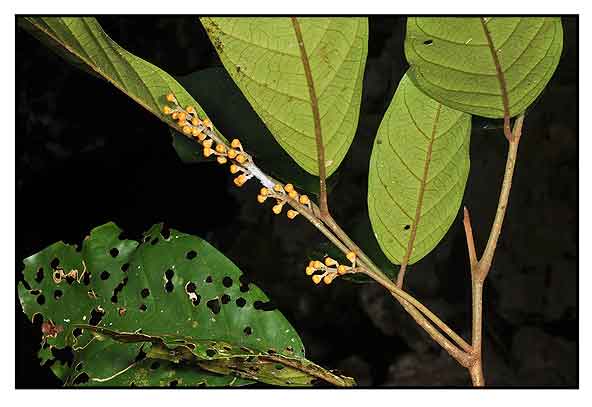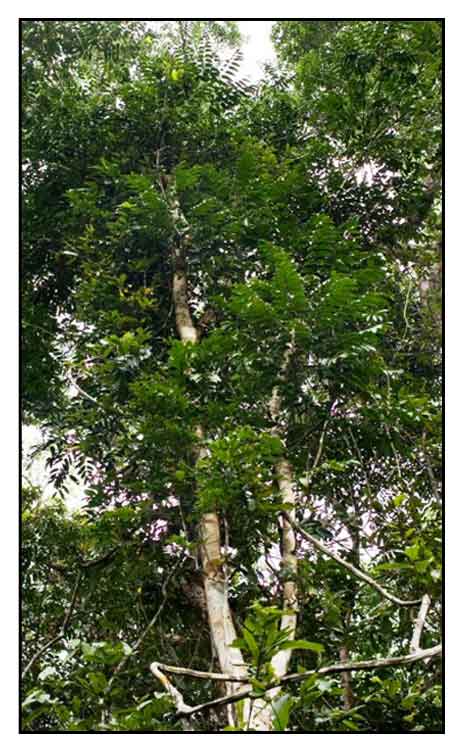 Gen info Gen info
- The genus Aglaia currently consists of 105 species, but it is expected more will be discovered. Within Malesia, the largest number of species is found in Borneo (50), followed by Peninsular Malaysia (48), Sumatera (38), Philippines (35), and New Guinea (33). (2)
- There is considerable morphological variation, and the genus presents with numerous taxonomic problems, with the number of accepted species varying from 117 to 390 depending on species concept used.
(12)
Botany
Aglaia elliptica is a tree 2–20(–40) m, with an irregularly rounded crown. Bark dark reddish-brown or greenish- brown with shallow pits, inner bark magenta; sapwood pale yellow pinkish-red or dark reddish-brown; latex white. Flowers up to 6,000, 1.2–1.5 mm long, 1–1.6 mm wide; pedicels 0.5–2 mm, with indumentum like the twigs. Flowers 1.8–2.2 mm long, 2–2.5 mm wide, otherwise similar. Petals5. Staminal tube 0.5–0.75 mm long, 1 mm wide, shallowly cup-shaped, yellow, thickened inside below the insertion of the anthers, the apical margin shallowly or deeply 5-lobed (in the rheophytic form, the staminal tube is divided almost to the base into 5 lobes); anthers c. 0.4 mm long and 0.3 mm  wide, yellow when immature, brown at anthesis, turning black later, ovoid, inserted just below the aperture and pointing towards the center of the flower. Fruits 1.5–3.5(–5) cm long, 1.5–3 (–5) cm wide, bright pale green when young, orange when mature, obovoid or ellipsoid, indéhiscent, with few to densely covered with reddish-brown stellate scales; pericarp 3–10 mm thick, inner surface shiny, orange, white latex present until fruit ripens, opening under pressure loculicidally along a longitudinal ridge encircling the fruit. Seeds 1 or 2, 2.2–2.8 cm long, 1–1.4 cm across, ovoid, the inner surface flattened; aril 2–3 mm thick, sometimes not quite complete on the antiraphe side, pinkish-orange, translucent, sweet or acidic tasting; with two layers beneath the aril, the outer hard, chestnut brown, the inner thin and membraneous, with the main vascular bundle running through the raphe and antiraphe, divaricately branching from the raphe over the sides of the seed. (Flora Malesiana) (14) wide, yellow when immature, brown at anthesis, turning black later, ovoid, inserted just below the aperture and pointing towards the center of the flower. Fruits 1.5–3.5(–5) cm long, 1.5–3 (–5) cm wide, bright pale green when young, orange when mature, obovoid or ellipsoid, indéhiscent, with few to densely covered with reddish-brown stellate scales; pericarp 3–10 mm thick, inner surface shiny, orange, white latex present until fruit ripens, opening under pressure loculicidally along a longitudinal ridge encircling the fruit. Seeds 1 or 2, 2.2–2.8 cm long, 1–1.4 cm across, ovoid, the inner surface flattened; aril 2–3 mm thick, sometimes not quite complete on the antiraphe side, pinkish-orange, translucent, sweet or acidic tasting; with two layers beneath the aril, the outer hard, chestnut brown, the inner thin and membraneous, with the main vascular bundle running through the raphe and antiraphe, divaricately branching from the raphe over the sides of the seed. (Flora Malesiana) (14)
Distribution
- Native to the Philippines.
- Also native to Borneo, Jawa, Lesser Sunda Is., Malaya, Myanmar, Sulawesi, Sumatera, Thailand. (1)
- Grows primarily in the wet tropical biome.
- in undisturbed mixed dipterocarp, sub-montane and swamp forests up to 2000 m altitude. Found in
primary and secondary forests, swamp forest, river banks, along roads, edges of marshes. (3)
 Constituents Constituents
- Study of stem bark isolated three new dammarane-type triterpenoids, elliptaglin A-C (1-3), along with three known derivatives, namely (20S)-hydroxydammar-24-em-3-on (4), cabralealactone (5), and E-25-hydroperoxydammar-23-en-20-ol-3-one (6). (see study below) (4)
- Bioassay-guided fractionation of the stems and fruits of Aglaia elliptica using human oral epidermoid carcinoma (KB) cells, led to the isolation of five cyclopenta[b]benzofurans, constituted by methyl rocaglate (1) and four novel compounds (2–5), along with three known dammarane triterpenoids. (see study below) (5)
- Study of leaves isolated two new diamides, 10-O-acetyl-aglain B (1) and 4-epiaglain A (2), two known diamides, aglain A (3) and odorine (4), and three known cycloartanes (5-7). (6)
- Study of stem bark isolated a new pregnane-type steroid, 2α-hydroxy-3α-methoxy-5α-pregnane (1), together with three known dammarane-type triterpenoid, 3β-acetyl-20S,24S-epoxy-25-hydroxydammarane (2), 20S,24S-epoxy-3α,25- dihydroxydammarane (3), and eichlerianic acid (4). (see study below) (9)
- Study of stem bark isolated two mixtures of flavanoid compounds (1 and 2), a mixture of catechin (1a) and epicatechin (1b), and a mixture of gallocatechin (2a) and epigallocatechin (2b). (see study below) (13)
Properties
- Studies have suggested anticancer, insecticidal properties.
Parts used
Leaves, bark, flowers.
Uses
Edibility
- Fruits are edible, with a taste of cranberry. (3)
Folkloric
- In the Mindanao, Philippines, leaves are applied to wounds. (3)
- Bathing in water boiled with bark used for treatment of tumors.
- In China, bark decoction used to treat tumors; flowers applied to wounds.
Others
- Wood: Hard and durable. Suitable for a wide range of uses: general construction, furniture, flooring, joists, posts, agricultural tools, etc. However, use limited by scarcity.
Studies
• Anticancer / Elliptaglin B / Stem Bark: Study of stem bark isolated three new dammarane-type triterpenoids, elliptaglin A-C (1-3), along with three known derivatives, namely (20S)-hydroxydammar-24-em-3-on (4), cabralealactone (5), and E-25-hydroperoxydammar-23-en-20-ol-3-one (6). Elliptaglin B (2) showed strongest activity against MCF-7 breast cancer and B16-F10 melanoma cell lines with IC50s of 60.98 and 51.83 µM, respectively. (4)
• Anticancer / Cytotoxic Lignans / Stems and Fruits: Study of stems and fruits isolated five cyclopenta[b]benzofurans and four novel compounds (2-5), along with three known dammarane triterpenoids. Compounds 1-5 were shown to be very potent cytotoxic substances when evaluated against a panel of human cancer cell lines. (see constituents above) (5)
• Anticancer / MCF-7 Breast Cancer Cell Line: Study evaluated three Indonesian medicinal plants Trigonella foenum-graecum, Aglaia elliptica, and Foeniculum vulgare for cytotoxicity activity on breast cancer cell lines MCF7. The ethanolic extract of A. elliptica showed the lowest IC50 (19.442 ppm) and apoptotic potency (11.94%), significantly increasing (p<0.05) % population of cells in subG0/G1 phase on 100 ppm concentration. (7)
• Rocaglamide / Cytotoxicity against HepG2 Hepatocarcinoma Cells / Leaves: Study evaluated Aglaia elliptica extracts from dry powdered leaves, fractions and subfractions. Three showed most toxic effect on brine shrimp lethality test, FEA 3.3, 3.4 and 3.5 with LC50s of 40.81. 28.56, and 13.40 ppm, respectively. The three subfractions were assayed on HepG2 hepatocarcinoma cells using MTT, and showed IC50s of 35.10, 14.36, and 14.08 ppm respectively. Three active compounds were suspected as derivatives of anticancer compound rocaglamide, which formed complex with Toll-like Receptor 4 in HepG2 hepatocarcinoma cells and affected the inhibition of proliferation of its cells. (8)
• Cytotoxic against P-388 Murine Leukemia Cells / Stem Bark: Study of stem bark isolated a new pregnane-type steroid, 2α-hydroxy-3α-methoxy-5α-pregnane (1), together with three known dammarane-type triterpenoid, 3β-acetyl-20S,24S-epoxy-25-hydroxydammarane (2), 20S,24S-epoxy-3α,25- dihydroxydammarane (3), and eichlerianic acid (4). Compounds 1-4 showed moderate cytotoxicity against P-388 murine leukemia cells. (9) Study of stem bark isolated two mixtures of flavanoid compounds (1 and 2), a mixture of catechin (1a) and epicatechin (1b), and a mixture of gallocatechin (2a) and epigallocatechin (2b). Compound 2 showed cytotoxicity against P-388 murine leukemia cell, with IC50 of 7.79 µg/mL. (13)
• Anticancer / Mammary Tumor Growth / Leaves: Study evaluated the inhibition effect of ethanol extract of A. elliptica leaves on mammary tumor growth in Sprague Dawley rats induced by DMBA. Histopathology suggested that carcinogenesis has reached the level of ductal carcinoma invasive (DCIV). Results showed administration of the ethanol extract at doses of 50, 100, and 200 mg/200 g BW suppressed the growth of mammary tumor volume by 30%, 33.5% and 37.4%, respectively. (10)
• Rocaglamide Derivatives / Insecticidal / Fruits : Study of fruits of A. elliptica and leaves of A. harmisiana yielded seven insecticidal rocaglamide derivatives. All rocaglamide derivatives isolated exhibited strong insecticidal activity towards neonate larvae of polyphagous pest insect Spodoptera littoralis when incorporated into an artificial diet with LC50 varying from 0.8-19.7 ppm. Didesmethyl-
rocaglamide was the most active compounds with LC50 of 0.9 ppm and EC50 of 0.05 ppm, identical to the positive control, azadirachtin. (11)
Availability
Wild-crafted.
|

![]()





 Constituents
Constituents